by W.S. Cranshaw* (1/18)
Quick Facts…
- Adult elm leaf beetles chew holes in elm leaves. The larvae feed on the leaf surface, producing skeletonizing injuries that make leaves look lacy.
- Adult elm leaf beetles often spend winter in and around buildings and may be common nuisance invaders found within homes during this period.
- Some insecticides that move systemically within plants can be applied to the soil to control elm leaf beetles.
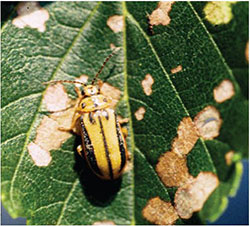
Figure 1. Elm leaf beetle adults and damage. |
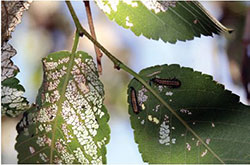
Figure 2. Skeletonizing injury to elm leaves produced by elm leaf beetle larvae. |
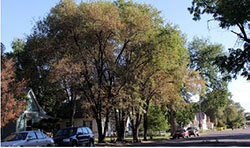
Figure 3. Trees showing leaf injury by elm leaf beetle. |
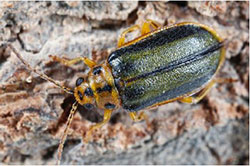
Figure 4. Elm leaf beetle adult, with the green coloration of the overwintering form. Photograph courtesy of Joseph Berger, Bugwood.org |
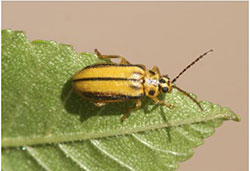
Figure 5. Elm leaf beetle, with the yellow coloration of the form found during the growing season. |
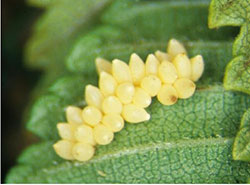
Figure 6. Egg mass of an elm leaf beetle. |

Figure 7. Elm leaf beetle larvae after egg hatch and associated leaf injury. |
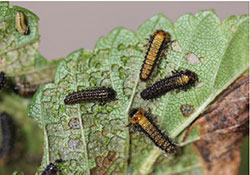
Figure 8. Late stage elm leaf beetle larvae. |

Figure 9. Elm leaf beetle pupae and last stage larvae, settled at the base of a tree. |
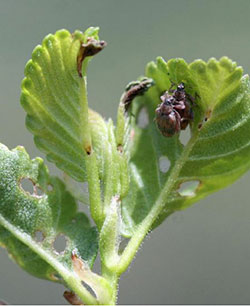
Figure 10. European elm flea weevil adults feeding on new growth on spring. |

Figure 11. Siberian elm leaf showing leaf mines and shot hole wounds produced by the larvae and adults of elm leaf beetles, respectively. |
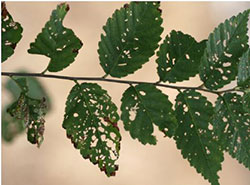
Figure 12. Shothole wounds produced by adults of European elm flea weevil. |
Elm leaf beetles (Xanthogaleruca luteola) are common insects that chew leaves of elm trees (Figure 1). The dark grub-like larvae chew on the underside of leaves but avoid the larger leaf veins, producing a type of injury pattern known as skeletonizing (Figure 2). Leaves damaged by elm leaf beetle larvae look lacy, turn brown and may prematurely drop from the trees (Figure 3). Adult beetles chew irregularly round holes in the center of leaves. Siberian and English elms are particularly favored by this insect.
Elm leaf beetles also can be important as a nuisance pest in homes, because they often enter buildings in autumn when seeking winter shelter. Beetles that do work their way behind walls and other areas of buildings may then be found indoors until spring, becoming most active during warm periods. Fortunately elm leaf beetles are strictly a nuisance invader type of insect that does not feed on nor damage anything within a home, although their very presence in a home is a common cause of concern.
Historically elm leaf beetles have been a major insect in Colorado communities where ever elm trees are common. However, since the mid-1990s, incidence of problems has declined in most areas of Colorado. In recent years problems have most often occurred in towns along the Arkansas River Valley, less commonly occurring as spot outbreaks elsewhere in eastern Colorado.
Beginning around 2006 an additional beetle arrived in Colorado that feeds on elm, the European elm flea weevil (Orchestes alni). European elm flea weevil produces some leaf injuries, such as shotholes in leaves, which are similar to those produced by adult elm leaf beetles. This new insect of elms is occurs throughout the state and is discussed at the end of this sheet.
Life History and Habits
Elm leaf beetles overwinter in the adult (beetle) stage. In late summer and early autumn they seek out protected sites such as woodpiles, loose mulch, and piled eaves to shelter through winter. Often cracks and other openings that allow them to get behind building walls serve as winter shelters. During this period the beetles are in a semi-dormant state (diapause) and are a khaki-green color (Figure 4). While in this dormant state they do not feed nor reproduce but may become active during warm days in late winter and spring.
In spring the beetles that survived winter become increasingly active and move to elm trees when leaves emerge. As the beetles feed their color shifts to more yellow-green and within a few weeks female beetles begin laying eggs (Figure 5). The eggs are yellow, typically laid on the underside of leaves in masses of one or two dozen (Figure 6).
Tiny, black larvae hatch from these eggs and originally they will chew small pits near where the eggs had been laid (Figure 7). As they get older and larger, elm leaf beetle larvae scatter through the tree. They feed on the underside of the leaf, avoiding the larger leaf veins, “skeletonizing” the leaves (Figure 8).
Within 3 to 4 weeks after eggs are laid, the larvae are full grown and they then wander to find sheltered spots where they can transform to their next stage, the pupa. Most crawl down the trunk and pupate at the base of the tree, sometimes in large groups (Figure 9). Others may settle into some of the larger fissures of the bark.
Within about two weeks, new adults emerge from the pupae. They then fly back to the leaves, mate, and produce a second generation. There follows a second cycle of larvae chewing leaves from mid-July into September. Adult beetles that are produced at the end of this second generation will feed for a brief while on leaves but do not lay eggs. They then move to overwintering shelter sites where they remain until the next spring.
Natural Controls
Few natural enemies feed on elm leaf beetles. Insect predators, such as predaceous stink bugs and plant bugs, may feed on various stages of the elm leaf beetle. There are small parasitic wasps that attack larvae and pupae, although incidence of these appears to be very low in Colorado. Some pupae may be killed by Beauveria bassiana, a fungus that produces disease in many insects, but infections with this disease require conditions of high humidity and outbreaks are uncommon in arid sites.
Weather probably is the most important factor that affects elm leaf beetle populations. Long winters or a late spring freeze may kill large numbers of overwintering beetles. Small larvae are susceptible to being blown or rubbed off trees during wind storms. This may be particularly common when larvae are forced to feed on older, tough leaves. This increases their wandering and many die in the process.
Chemical Control
Chemical controls can effectively control elm leaf beetles. These are best used in areas where outbreaks regularly occur or when large numbers of beetles are observed laying eggs, an indication of a potential outbreak. Insecticides can be employed in three ways to manage elm leaf beetle: 1) use of soil drenches/soil injections of systemic insecticides that move to kill insects on foliage; 2) use of sprays covering leaves to directly contact and kill larvae and adults; and 3) trunk banding with insecticides to kill larvae as they move to the base of the tree to pupate.
Soil Applied Systemic Insecticides
A few insecticides are systemic in plants, capable of moving through the plant providing so that they may control insects some distance from where the insecticide is applied. Most useful for control of elm leaf beetle are insecticides that can be applied to the soil and that then can move to the leaves where elm leaf beetles feed.
Imidacloprid is the most commonly available insecticide that moves systemically in plants and can be used in elm leaf beetle control. Less commonly available is chlothianidin, a chemically related material also in the neonicotinoid class of insecticides (Table 1). These are used as a soil application applied to areas where roots absorb the insecticide then move the insecticide into and through the plant. These insecticides can be applied as either soil drench around the base of the tree or as a series soil injections spread to areas under the crown. Rates of insecticide are indicated in label instructions and are usually indicated as being related to either the diameter (commercial formulations) or circumference (over-the-counter/retail formulations) of the tree.
Table 1. Insecticides that can be used to control elm leaf beetles. Products are listed by Active Ingredient (in bold). Some trade names/formulations of these insecticides are listed in parentheses.
Soil applied systemic insecticides
Imidacloprid (Bayer Advanced Tree & Shrub Protect & Feed Concentrate II, Bonide Annual Tree & Shrub Control, ferti-lome Tree & Shrub Systemic Insect Drench; Ortho Bug B Gon Year-Long Tree & Shrub Insect Control, Merit, Mallet, Zenith, Criterion, others)
Chlothianidin (Bayer Advanced Tree & Shrub Protect & Feed Concentrate II, Arena)
Insecticides applied as sprays to leaves
Azadirachtin (Azatin, AzaGuard, Azasol, BioNeem, others)
Bifenthrin (Talstar, Onyx, Ortho Bug B Gon Insect Killer for Lawns & Gardens)
Carbaryl (Sevin, Carbaryl)
Cyfluthrin (Tempo, Bayer Advanced Vegetable & Garden Insect Spray)
Cyhalothrin (Scimitar, Spectracide Triazicide Insect Killer for Lawns & Landscapes, Cutter Backyard Bug Control Spray Concentrate
Permethrin (Astro, Permethrin, Hi-Yield Turf, Termite and Ornamental 38 Plus, Bonide Eight Insect Control Yard & Garden, others)
Spinosad (Conserve, Bonide Captain Jack’s Dead Bug Brew, Natural Guard Spinosad Landscape & Garden Insecticide, ferti-lome Borer, Bagworm, Leafminer & Tent Caterpillar Spray)
After application there will be a lag period before the insecticide moves from the soil into the leaves in enough concentration to control elm leaf beetles. Since both imidacloprid and chlothianidin move fairly slowly in soil this typically takes about two to four weeks. Most important in how quickly these insecticides move into the leaves is the how moist is the soil where the insecticides were applied. For effective control of elm leaf beetle it is very important that the soil is kept moist in the area where the insecticide was applied, which under Colorado conditions usually requires some supplemental irrigation.
Sprayed Treatments
Several insecticides (Table 1) can be used to control elm leaf beetles feeding on leaves. These treatments are best applied after most eggs are laid by the overwintering females but before the larvae start to cause significant injury to the leaves. For the first generation of elm leaf beetle in southeast Colorado this typically occurs in late May or early June.
Most of the insecticides applied as sprays will have several days of persistence in ability to kill elm leaf beetles. This can be a useful feature if many eggs remain unhatched when sprays are made. Other insecticides, such as the neem-derived products (azadirachtin) and biological insecticides (spinosad) have short persistence and should be timed to periods after egg hatch.
Trunk Banding
Some control of late season elm leaf beetle feeding injury is possible by spraying a band of insecticide on trunks to kill larvae that crawl to the base of the tree when they have finish the first cycle of feeding in early summer. The bands should be at least one foot wide and placed on the trunk just below where the lowest major branches join the trunk. Any insecticide registered for use on elm or shade trees can be used for trunk banding. However, rates of dilution and use must not exceed the amounts indicated on the pesticide label. Pyrethroid insecticides, such as bifenthrin, permethrin, and cyfluthrin, have shown effective persistence when used as trunk bands.
Elm Leaf Beetles in a Home
In late summer elm leaf beetles seeking winter shelter may move into nearby homes, becoming a seasonal nuisance invader. To avoid this preventive steps can be taken to exclude the insects. Prior to periods when beetles move to homes, seal all cracks that allow entry. Caulk areas around window molding or under siding. Screens should be in place. Typically, adult beetles start to migrate to overwintering shelter in mid-August, but movements greatly increase by early September.
Some increase in control is possible if sealing is accompanied by spot insecticide treatment of the building exterior at points where beetles may find entry intro buildings, such as around windows. Several formulations of pyrethroid insecticides (active ingredients include permethrin, bifenthrin, cyhalothrin, cyfluthrin) are available for this use.
Regular vacuuming is most effective for beetles that are found within a home. This is best done during warm periods when most of the beetles are active and mass on windows or walls. During cooler periods, the overwintered beetles often return to sheltered areas.
Elm leaf beetles do not reproduce in homes. Although some may emerge and move about during warms periods, the beetles that spend winter in buildings are harmless and they do not feed nor damage household foods and furnishings. These nuisance problems end by mid-late spring, after all beetles have either moved outdoors or died.
European elm flea weevil – A new insect pest of elms
Another beetle that feeds on elm and is now present in Colorado is the European elm flea weevil (Figure 10). This insect was accidentally introduced into North America and found its way to Colorado fairly recently, being first identified in 2006. In a very short period following this initial finding it was found to be present statewide.
European elm flea weevils are much smaller than elm leaf beetles and are capable of jumping. They do not have the habit of using buildings as sheltered sites, but remain outdoors through winter. The adults then move to elm trees as buds break and feed on the emerging leaves, producing small shothole wounds in the leaves.
Females then begin to lay eggs. Eggs are laid individually, not as a mass, and are inserted into the leaf. Upon hatch, the larvae then feed within the leaf, between the upper and lower surfaces, as a type of leafminer (Figure 11). The pattern of the leaf mine they produce originally meanders, getting wider as the insect grows, and terminates at the edge of the leaf, producing a blotchy mine. The larvae complete their development in the leaf mine and then pupate.
Adults emerge in late June and early July. They then go through another cycle of leaf feeding, producing more shothole feeding wounds on leaves (Figure 12). Later in summer they abandon the plants and seek areas for winter shelter, in bark cracks, under fallen leaves and in similar protected areas. One generation is produced each year.
European elm flea weevils were quite abundant and produced very conspicuous leaf damage in the first few years after they arrived in Colorado. However, more recently natural enemies of the insect have become established, notably a type of parasitic wasp, and these have greatly reduced numbers of European elm flea weevil and its associated injury. Insecticide controls are not recommended for European elm flea weevil, although they may be killed by some of the treatments used for elm leaf beetle.
*W.S. Cranshaw, Colorado State University Extension entomologist and professor, bioagricultural sciences and pest management. 11/96. Revised 1/18.
Colorado State University, U.S. Department of Agriculture, and Colorado counties cooperating. Extension programs are available to all without discrimination. No endorsement of products mentioned is intended nor is criticism implied of products not mentioned.
Go to top of this page.





